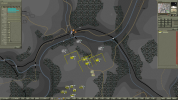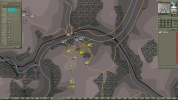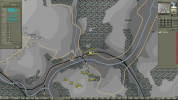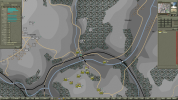Thanks for all the info. It's a pity that none of this is official information. To my eyes these are very basic questions that need to be well documented in the manual (also: basic combat resolution should be covered*). We're still stuck with a lot of cryptic aspects, as nobody seems to know for sure what many unit stats and, especially, order-settings do.
For example, what does it mean when I read "an aggressive commander is more likely to initiate an attack"? Obviously, this does not refer to a standard attack order for a battalion, which, to my knowledge consists of 1) all units moving to the FUP, 2) assigning support, reserve and attack-elements (based on the aggro-setting of the order?), 3) setting up groups/roles for each group (e.g. right guard/left guard, etc.) and 4) actually launching the attack (the assault group moving forward in the specified formation). None of this is up to the AI of the commander? Also, I can't see how a less aggressive commander could "bypass" the enemy with an attack-order?
So, perhaps does it refer to enemy contact made during a movement order/task? Here I think that commanders do some re-assessment at longish intervalls to determine how to react to contact. E.g. when a road column's advance guard makes contact, the commander might deploy his formation and attack?
Or perhaps it refers to higher level HQs only?
------------------
* It would be great to have some basic idea on what's going on when two units engage?
When/at what range and how often does a unit fire (i.e. fire a tracer)? I suppose suppression or being in retreat-recovery reduces the chance of a unit to fire? Also, I figured out that the actual footprint of a unit (which changes according to formation) does not matter when it comes to range - judging from range-rings, units are always considered to be "points".
If engaged while moving, when/why does a unit stop? Can the player take any influence here?
IIt's obvious that a unit's fire can have various degrees of strength. For example, the game uses different sounds to represent different fire-strengths (for small arms, at least). How is the strength of the fire determined? I guess that range+weapons+reliability, formation+facing and cohesion, morale, experience play a role? What are the effects of the strength of fire? One would assume that a greater strength of fire would have a higher chance to inflict casualties on the enemy (red lamp instead of yellow lamp)? This chance, on the other hand, will be modified by the enemy's fortification status (again, we lack information on the stregnth of fortification-status in different kinds of terrain) and formation?
What about the "rate of fire"-order-option? Does it decrease the chance to fire, or decrease fire-strength?
On the receiving end: what causes retreat-checks? Does a unit need to suffer casualties, or is being under fire enough to trigger a retreat check? What affects the chances for retreat? Is cohesion or morale more important? How does "stubbornness" factor in here? Do fortifications play a role as well? And how does a unit decide whether it actively retreats or prefers stationary retreat-recovery?
-------------
This should not come off as a rant. I love the game. It's just that the documenation is lackluster. Especially in a game like this, I think that players should be given infromation about some (very basic) aspects of the game - like what different order-settings do, what unit- and commander stats actually mean, and how engagements are resolved and how order-delay works. Other aspects, like the AI's routines for different types of orders, are meta-aspects compared to these basic questions.

 . however, the whole battalion stops and takes it time to first destroy/ rout the enemy unit before capturing. Is there a way to increase their capture speed?
. however, the whole battalion stops and takes it time to first destroy/ rout the enemy unit before capturing. Is there a way to increase their capture speed?



